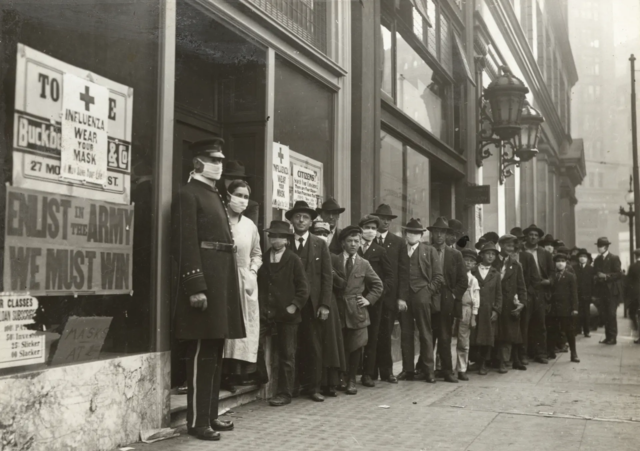5.7 Human Responses to Pandemics

Pandemic Denial & Anti-Masking Sentiments
Throughout history and within contemporary society, disease and pandemics have typically been accompanied by extreme accusations, denial, misinformation, and mistrust (Navarro, 2020; Newey, 2020), which only exacerbate the death toll (Little, 2020b). Examples of pandemic denial were evident during the Spanish flu. During the flu’s first wave in the spring and early summer of 1918, some European and U.S. newspapers claimed that the flu wasn’t a serious threat (Little, 2020b). In the late summer, during the deadly second wave, the Interior Minister of Italy denied reports of the flu spreading (Martini et al., 2019). Anti-masking claims were also evident during the Spanish flu pandemic (Carstairs, 2020; McMullan et al., 2020; Navarro, 2020). Although there was wide-spread support for wearing masks, support waned quickly and masking compliance levels fell, due to issues of comfort, doubts regarding efficacy, and impact on businesses/commerce (Carstairs, 2020; Little, 2020a; Navarro, 2020). This rings true during the COVID-19 pandemic as well. Less than half of the people in the U.S. follow health recommendations to wear a mask when out in public (Key, 2021; Miller, 2020).
Click the link below to learn more about the history of anti-masking sentiments:
Masking Resistance During A Pandemic Isn’t New – In 1918 Many Americans Were “Slackers”
Misinformation & Scapegoating
The stigmatizing and scapegoating of convenient targets is common during pandemics (Cole, 2020). Pandemic misinformation, conspiracy theories and the impact of low-science literacy levels, are integral in creating and reinforcing “us versus them” mindsets that lead to stigmatizing, scapegoating, and targeting of certain populations during pandemics (Miller, 2020; Poos, 2020). During the Black Death, Jewish people were blamed for spreading the plague by poisoning wells and streams. This led to the mass murder of the Jewish population by Christian mobs, across hundreds of communities (Cole, 2020; Poos, 2020). In 19th century U.S, immigrants were blamed for a variety of infections, including polio and cholera (Cole, 2020). Despite the Spanish Flu being accelerated by the movement of soldiers during WWI, German submarines and “enemy agents” were blamed for the spread of the flu by allied nations (e.g., the UK, U.S.) (Newey, 2020). With AIDS, the 2SLGBTQi community was targeted, followed by people who inject drugs (PWID), Haitians, and people with Hemophilia (Altman, 1983). With COVID-19, hate, violence and blame has been levelled against people of Asian descent, resulting from its label as “the China virus” (Lu, 2021; Poos, 2020; Vazquez, 2020).
The Anti-Vaccination Movement
Another common feature of both past and present pandemics is disinformation, including: the denial of the safety and importance of vaccinations. The deep-rooted beliefs that underlie vaccine opposition have remained somewhat consistent since the introduction of smallpox vaccine in 1796, the very first vaccine created (Haelle, 2020; Youngdahl, 2016), although the exact concerns vary according to the cultural anxieties of the time (Haelle, 2021; Poos, 2020). Anti-Vaccination leagues, founded in the mid- to late-1800s in the U.K. and U.S, spurred anti-vaccination sentiments and distrust of medicine. This resulted in the questioning of the safety and efficacy of, and the motives behind, the smallpox vaccine and every vaccine developed since then (e.g., Diphtheria, Tetanus, Polo [DTP]; Measles, Mumps and Rubella [MMR]) (Haelle, 2021; McNamara, 2021; Youngdahl, 2016).
Vaccine hesitancy has had negative public health impacts. In terms of smallpox, anti-vaccination sentiments led to a significant decline in immunization rates, and the re-emergence of smallpox just a couple of decades later (McNamara, 2021). Over the past few decades, hesitancy has led to “outbreaks of communicable infections such as measles” (Geoghegan et al., 2020, p. 1). With COVID-19, we find rates of hospitalization and death increase in regions where vaccine hesitancy and resistance to other health preventive measures, like masking and social distancing, are prevalent (Hanna et al., 2021). We also see attacks against people associated with the virus, vaccines, and public health measures. This ranges from violence against people of Asian descent (Lu, 2021; Poos, 2020; Vazquez, 2020), to the picketing of hospitals, as well as harassment and assault of medical and hospital personnel (Larkin, 2021; Miller, 2021; Ungerleider & Warren, 2022).
The deliberate misleading of people "for political, ideological or other reasons" (Haelle, May 11, 2021).

